Abstract
Data on individual exposure to 2,4-dichlorophenoxyacetic acid (2,4-D) in herbicide production plants are limited. Hence, the urinary excretion of this herbicide was measured during a five year (1985-1989) biological monitoring study of 27 men and 18 women employees exposed during the production and formulation of 2,4-D and related sodium and dimethylamine salts. In separate studies, specimens of urine were collected in the morning, or during the last three hours of a working shift, or over a 24 hour period (1200 to 1200 or 0800 to 0800) and were analysed by an immunochemical method (2,4-D radioimmunoassay (RIA)). Urinary 2,4-D concentrations varied within a large scale from only a few micrograms/l to several 10s of mg/l. During a week, herbicide excretion increased, culminating on Friday. At the weekend, when no work was done, 2,4-D elimination decreased but did not return to zero in any case. After an interruption of exposure for about three weeks, urinary 2,4-D was no longer detectable. About five days after restarting work, body concentrations had built up again. Measurements of 2,4-D concentrations in air at different work-places showed that herbicide concentrations did not exceed 0.5 mg/m3. As well as inhalation, dermal 2,4-D absorption seemed to play an important part in total uptake of herbicide. Furthermore, a strong correlation was found (r = 0.9628) between 2,4-D urinary concentration, adjusted for endogenous creatinine, and the estimated amount of absorbed herbicide. Estimated absorbed doses were, in most cases, well below 0.1 mg 2,4-D/kg body wt/day. Sometimes this concentration was greatly exceeded. Thyroid hormone concentrations in blood were measured as well. No notable abnormalities were found. Exposed subjects were also typed for histocompatibility locus antigens (ABC antigens). The immunochemical determination of 2,4-D in specimens of urine proved to be a simple, cost effective, and non-invasive method to measure human exposure.
Full text
PDF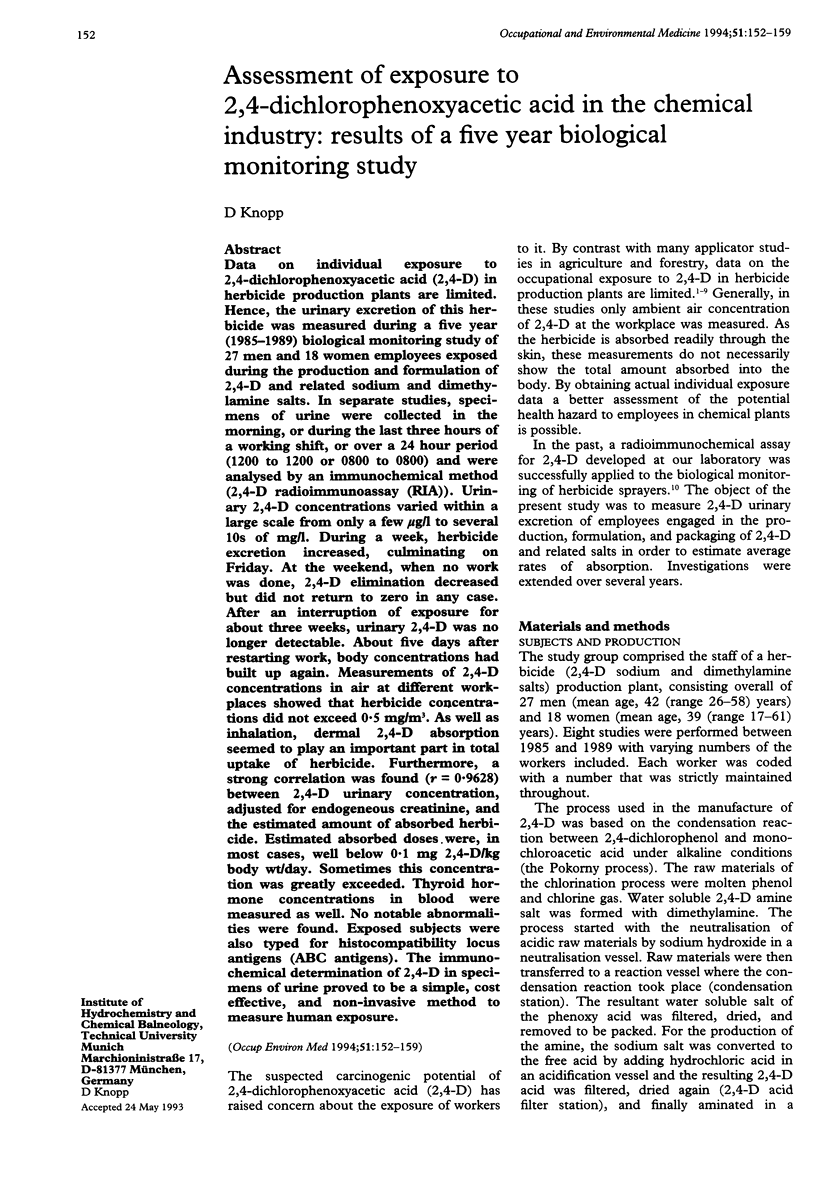
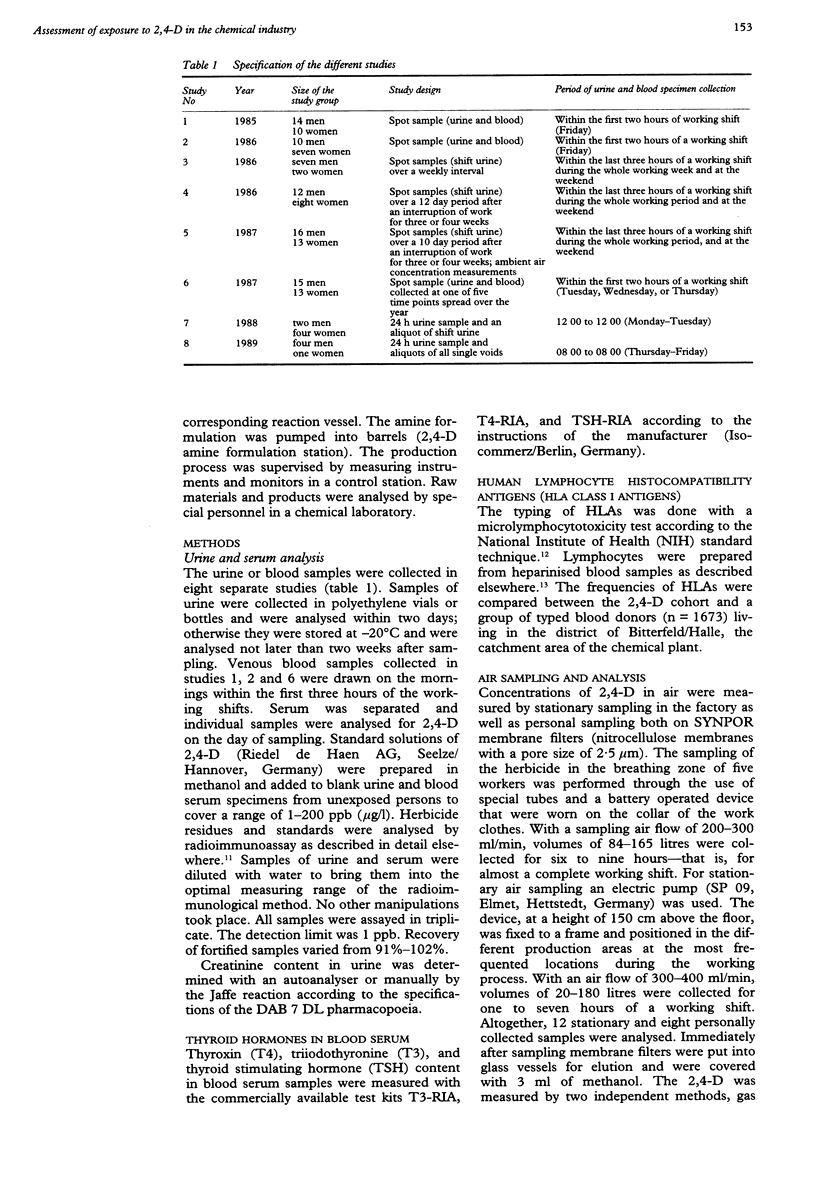
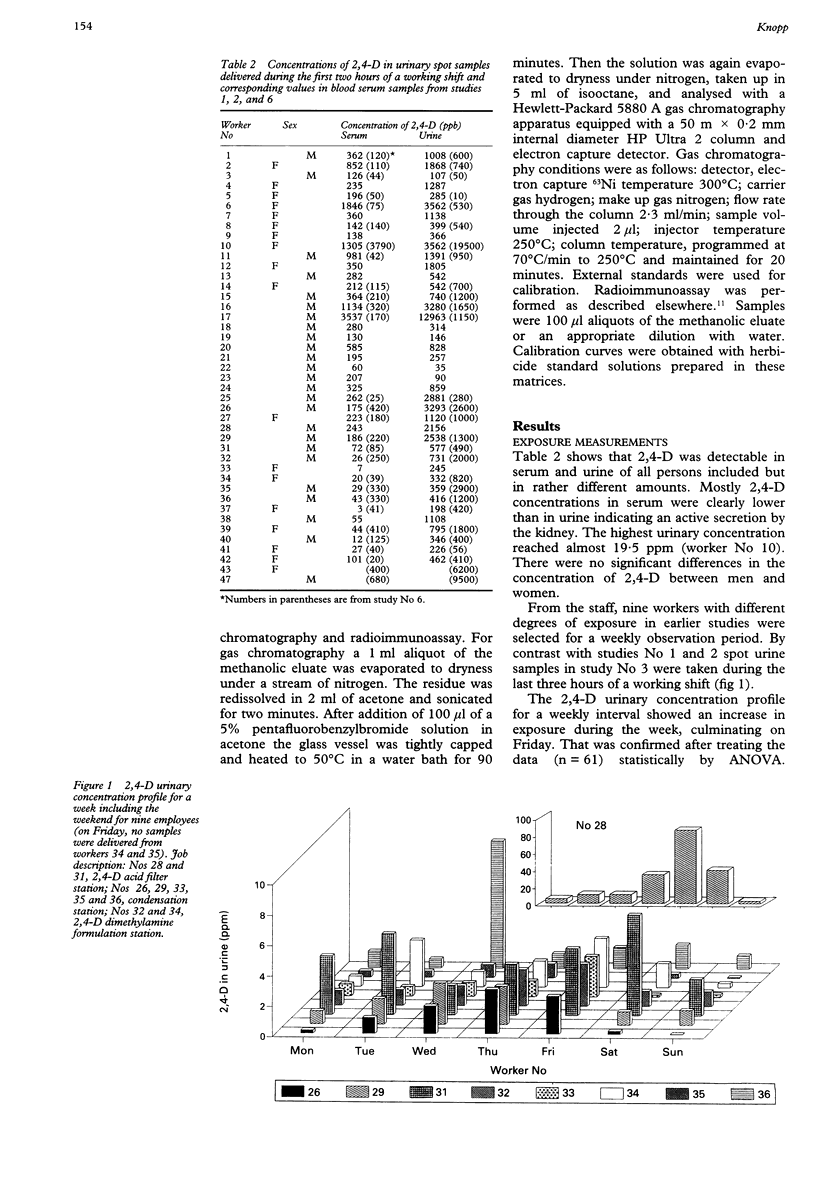
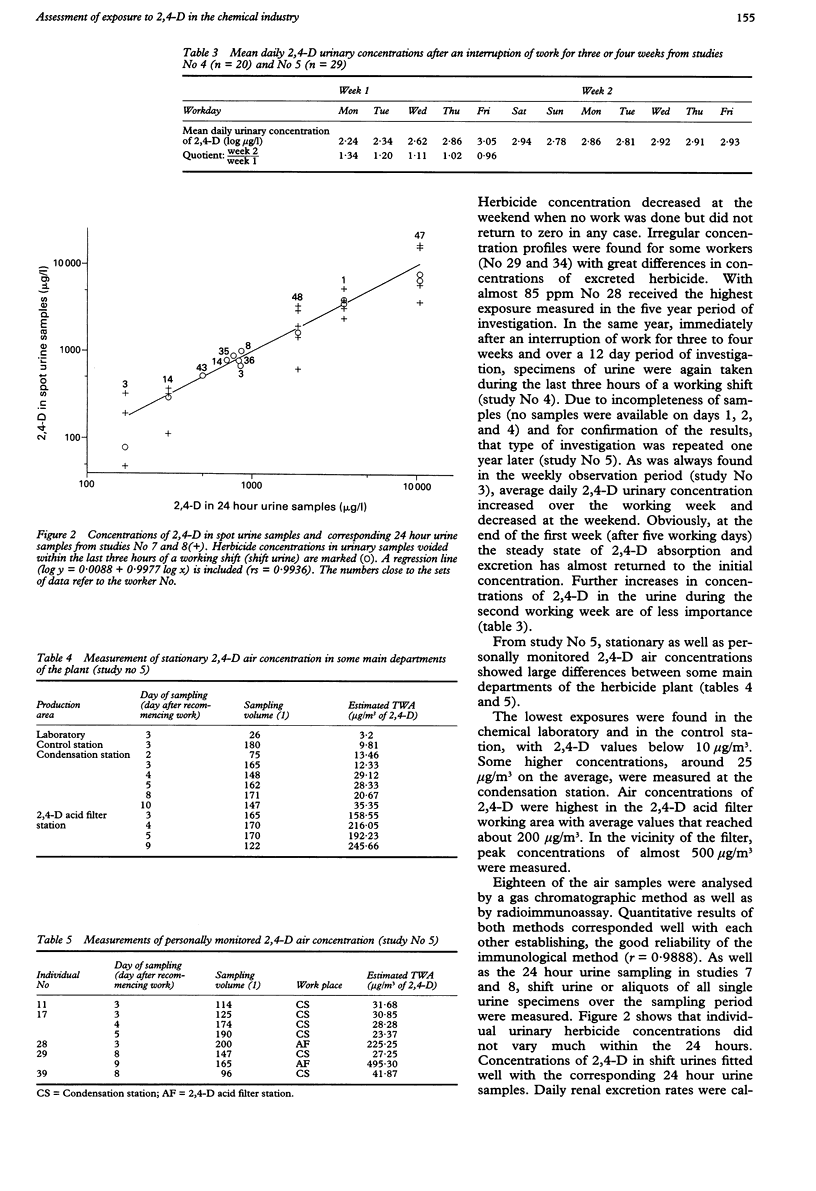
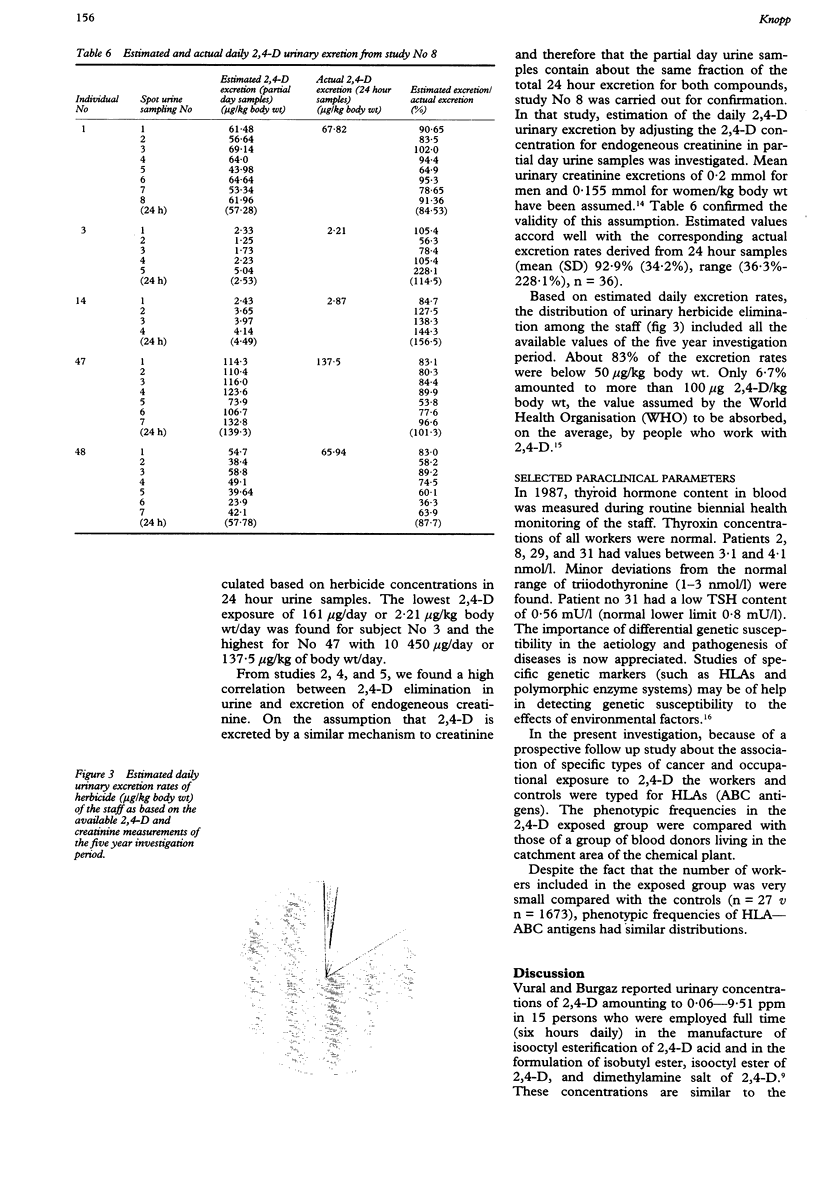
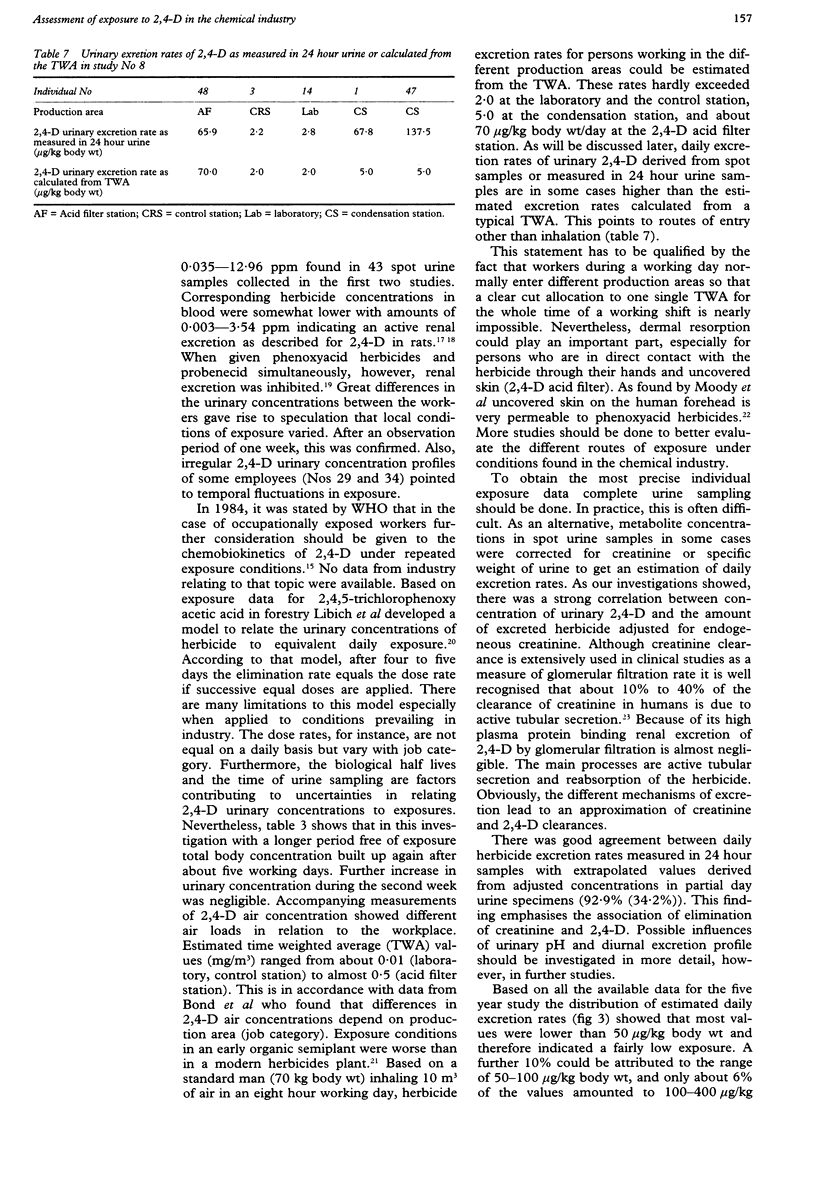
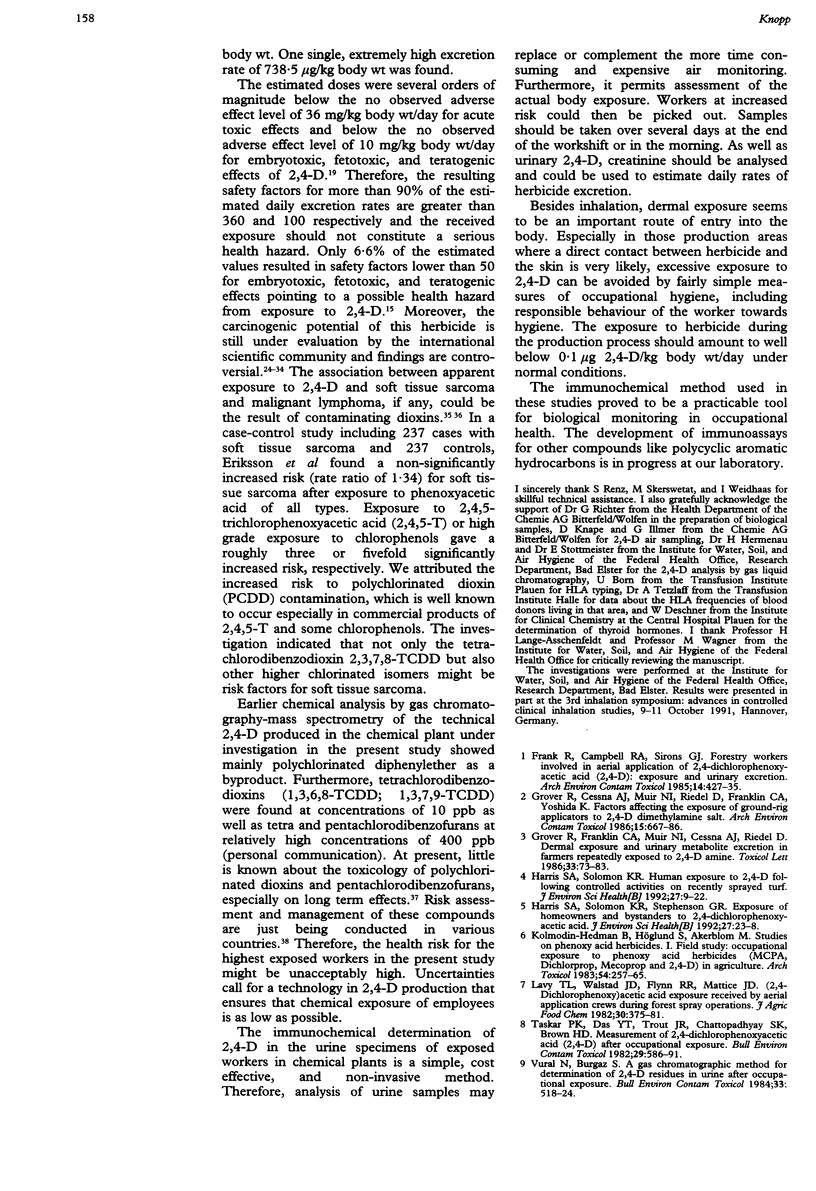
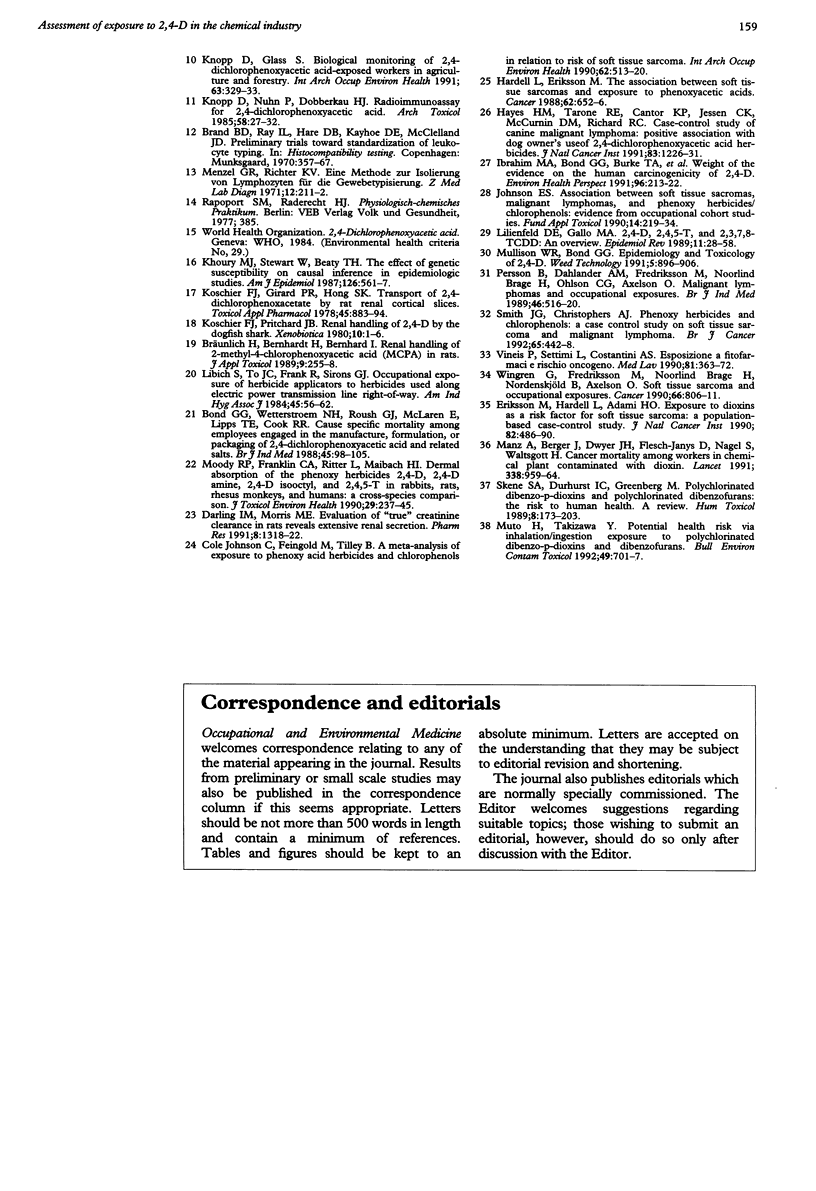
Selected References
These references are in PubMed. This may not be the complete list of references from this article.
- Bond G. G., Wetterstroem N. H., Roush G. J., McLaren E. A., Lipps T. E., Cook R. R. Cause specific mortality among employees engaged in the manufacture, formulation, or packaging of 2,4-dichlorophenoxyacetic acid and related salts. Br J Ind Med. 1988 Feb;45(2):98–105. doi: 10.1136/oem.45.2.98. [DOI] [PMC free article] [PubMed] [Google Scholar]
- Bräunlich H., Bernhardt H., Bernhardt I. Renal handling of 2-methyl-4-chlorophenoxyacetic acid (MCPA) in rats. J Appl Toxicol. 1989 Aug;9(4):255–258. doi: 10.1002/jat.2550090409. [DOI] [PubMed] [Google Scholar]
- Darling I. M., Morris M. E. Evaluation of "true" creatinine clearance in rats reveals extensive renal secretion. Pharm Res. 1991 Oct;8(10):1318–1322. doi: 10.1023/a:1015820316660. [DOI] [PubMed] [Google Scholar]
- Eriksson M., Hardell L., Adami H. O. Exposure to dioxins as a risk factor for soft tissue sarcoma: a population-based case-control study. J Natl Cancer Inst. 1990 Mar 21;82(6):486–490. doi: 10.1093/jnci/82.6.486. [DOI] [PubMed] [Google Scholar]
- Frank R., Campbell R. A., Sirons G. J. Forestry workers involved in aerial application of 2,4-dichlorophenoxyacetic acid (2,4-D): exposure and urinary excretion. Arch Environ Contam Toxicol. 1985 Jul;14(4):427–435. doi: 10.1007/BF01055528. [DOI] [PubMed] [Google Scholar]
- Grover R., Franklin C. A., Muir N. I., Cessna A. J., Riedel D. Dermal exposure and urinary metabolite excretion in farmers repeatedly exposed to 2,4-D amine. Toxicol Lett. 1986 Oct;33(1-3):73–83. doi: 10.1016/0378-4274(86)90072-x. [DOI] [PubMed] [Google Scholar]
- Hardell L., Eriksson M. The association between soft tissue sarcomas and exposure to phenoxyacetic acids. A new case-referent study. Cancer. 1988 Aug 1;62(3):652–656. doi: 10.1002/1097-0142(19880801)62:3<652::aid-cncr2820620334>3.0.co;2-4. [DOI] [PubMed] [Google Scholar]
- Harris S. A., Solomon K. R. Human exposure to 2,4-D following controlled activities on recently sprayed turf. J Environ Sci Health B. 1992 Feb;27(1):9–22. doi: 10.1080/03601239209372764. [DOI] [PubMed] [Google Scholar]
- Hayes H. M., Tarone R. E., Cantor K. P., Jessen C. R., McCurnin D. M., Richardson R. C. Case-control study of canine malignant lymphoma: positive association with dog owner's use of 2,4-dichlorophenoxyacetic acid herbicides. J Natl Cancer Inst. 1991 Sep 4;83(17):1226–1231. doi: 10.1093/jnci/83.17.1226. [DOI] [PubMed] [Google Scholar]
- Ibrahim M. A., Bond G. G., Burke T. A., Cole P., Dost F. N., Enterline P. E., Gough M., Greenberg R. S., Halperin W. E., McConnell E. Weight of the evidence on the human carcinogenicity of 2,4-D. Environ Health Perspect. 1991 Dec;96:213–222. doi: 10.1289/ehp.9196213. [DOI] [PMC free article] [PubMed] [Google Scholar]
- Johnson C. C., Feingold M., Tilley B. A meta-analysis of exposure to phenoxy acid herbicides and chlorophenols in relation to risk of soft tissue sarcoma. Int Arch Occup Environ Health. 1990;62(7):513–520. doi: 10.1007/BF00381182. [DOI] [PubMed] [Google Scholar]
- Johnson E. S. Association between soft tissue sarcomas, malignant lymphomas, and phenoxy herbicides/chlorophenols: evidence from occupational cohort studies. Fundam Appl Toxicol. 1990 Feb;14(2):219–234. doi: 10.1016/0272-0590(90)90203-v. [DOI] [PubMed] [Google Scholar]
- Khoury M. J., Stewart W., Beaty T. H. The effect of genetic susceptibility on causal inference in epidemiologic studies. Am J Epidemiol. 1987 Oct;126(4):561–567. doi: 10.1093/oxfordjournals.aje.a114695. [DOI] [PubMed] [Google Scholar]
- Knopp D., Glass S. Biological monitoring of 2,4-dichlorophenoxyacetic acid-exposed workers in agriculture and forestry. Int Arch Occup Environ Health. 1991;63(5):329–333. doi: 10.1007/BF00381583. [DOI] [PubMed] [Google Scholar]
- Knopp D., Nuhn P., Dobberkau H. J. Radioimmunoassay for 2,4-dichlorophenoxyacetic acid. Arch Toxicol. 1985 Oct;58(1):27–32. doi: 10.1007/BF00292612. [DOI] [PubMed] [Google Scholar]
- Kolmodin-Hedman B., Höglund S., Akerblom M. Studies on phenoxy acid herbicides. I. Field study. Occupational exposure to phenoxy acid herbicides (MCPA, dichlorprop, mecoprop and 2,4-D) in agriculture. Arch Toxicol. 1983 Dec;54(4):257–265. doi: 10.1007/BF01234478. [DOI] [PubMed] [Google Scholar]
- Koschier F. J., Girard P. R., Hong S. K. Transport of 2,4-dichlorophenoxyacetate by rat renal cortical slices. Toxicol Appl Pharmacol. 1978 Sep;45(3):883–894. doi: 10.1016/0041-008x(78)90179-5. [DOI] [PubMed] [Google Scholar]
- Koschier F. J., Pritchard J. B. Renal handling of 2,4-D by the dogfish shark (Squalus acanthias). Xenobiotica. 1980 Jan;10(1):1–6. doi: 10.3109/00498258009033724. [DOI] [PubMed] [Google Scholar]
- Libich S., To J. C., Frank R., Sirons G. J. Occupational exposure of herbicide applicators to herbicides used along electric power transmission line right-of-way. Am Ind Hyg Assoc J. 1984 Jan;45(1):56–62. doi: 10.1080/15298668491399370. [DOI] [PubMed] [Google Scholar]
- Lilienfeld D. E., Gallo M. A. 2,4-D, 2,4,5-T, and 2,3,7,8-TCDD: an overview. Epidemiol Rev. 1989;11:28–58. doi: 10.1093/oxfordjournals.epirev.a036044. [DOI] [PubMed] [Google Scholar]
- Manz A., Berger J., Dwyer J. H., Flesch-Janys D., Nagel S., Waltsgott H. Cancer mortality among workers in chemical plant contaminated with dioxin. Lancet. 1991 Oct 19;338(8773):959–964. doi: 10.1016/0140-6736(91)91835-i. [DOI] [PubMed] [Google Scholar]
- Menzel G. R., Richter K. V. Eine Methode zur Isolierung von Lymphozyten für die Gewebetypisierung. Z Med Labortech. 1971;12(4):211–212. [PubMed] [Google Scholar]
- Moody R. P., Franklin C. A., Ritter L., Maibach H. I. Dermal absorption of the phenoxy herbicides 2,4-D, 2,4-D amine, 2,4-D isooctyl, and 2,4,5-T in rabbits, rats, rhesus monkeys, and humans: a cross-species comparison. J Toxicol Environ Health. 1990;29(3):237–245. doi: 10.1080/15287399009531387. [DOI] [PubMed] [Google Scholar]
- Muto H., Takizawa Y. Potential health risk via inhalation/ingestion exposure to polychlorinated dibenzo-p-dioxins and dibenzofurans. Bull Environ Contam Toxicol. 1992 Nov;49(5):701–707. doi: 10.1007/BF00200783. [DOI] [PubMed] [Google Scholar]
- Persson B., Dahlander A. M., Fredriksson M., Brage H. N., Ohlson C. G., Axelson O. Malignant lymphomas and occupational exposures. Br J Ind Med. 1989 Aug;46(8):516–520. doi: 10.1136/oem.46.8.516. [DOI] [PMC free article] [PubMed] [Google Scholar]
- Skene S. A., Dewhurst I. C., Greenberg M. Polychlorinated dibenzo-p-dioxins and polychlorinated dibenzofurans: the risks to human health. A review. Hum Toxicol. 1989 May;8(3):173–203. doi: 10.1177/096032718900800301. [DOI] [PubMed] [Google Scholar]
- Smith J. G., Christophers A. J. Phenoxy herbicides and chlorophenols: a case control study on soft tissue sarcoma and malignant lymphoma. Br J Cancer. 1992 Mar;65(3):442–448. doi: 10.1038/bjc.1992.90. [DOI] [PMC free article] [PubMed] [Google Scholar]
- Taskar P. K., Das Y. T., Trout J. R., Chattopadhyay S. K., Brown H. D. Measurement of 2,4-dichlorophenoxyacetic acid (2,4-D) after occupational exposure. Bull Environ Contam Toxicol. 1982 Nov;29(5):586–591. doi: 10.1007/BF01669625. [DOI] [PubMed] [Google Scholar]
- Vineis P., Settimi L., Seniori Costantini A. Esposizione a fitofarmaci e rischio oncogeno. Med Lav. 1990 Sep-Oct;81(5):363–372. [PubMed] [Google Scholar]
- Vural N., Burgaz S. A gas chromatographic method for determination of 2,4-D residues in urine after occupational exposure. Bull Environ Contam Toxicol. 1984 Nov;33(5):518–524. doi: 10.1007/BF01625578. [DOI] [PubMed] [Google Scholar]
- Wingren G., Fredrikson M., Brage H. N., Nordenskjöld B., Axelson O. Soft tissue sarcoma and occupational exposures. Cancer. 1990 Aug 15;66(4):806–811. doi: 10.1002/1097-0142(19900815)66:4<806::aid-cncr2820660435>3.0.co;2-u. [DOI] [PubMed] [Google Scholar]


